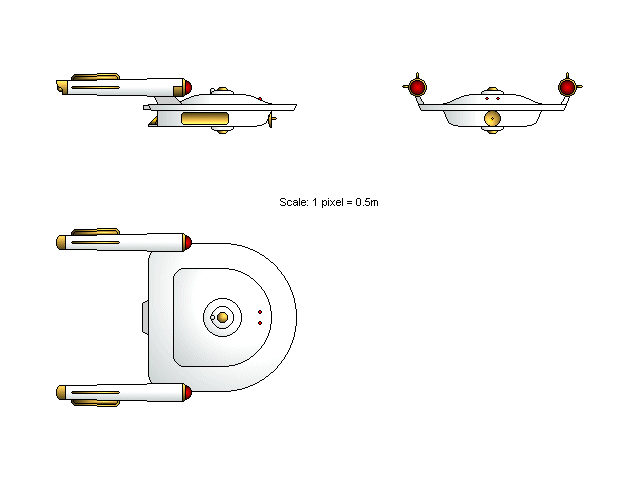
Designer: Robert C. Dunehew. E-mail [email protected]

Hawkeye surveillance frigate
Inscription on Commissioning Plaque:
"You can observe a lot just by watching."General Specifications:--Yogi Berra
Armament: Three lasers (1 fwd bank of 2, 1 aft); later refit to phasers in 2267; one accelerator cannon (aft); refit to photon torpedo launcher in 2267.
Type: Surveillance frigate
Status: 38 built between 2229 and 2233. All vessels refit in 2267. In 2385, the Hawkeyes were converted to cargo vessels.
About Ship: By the early 23d century, Starfleet had been spending much of the past 50 years designing ships that would never be built. The Federation was unwilling to provide funding for ships it felt it did not need. At the time, the Romulans were safely contained behind the Neutral zone. It was thought very unlikely that another threat to security existed nearby, certainly not enough to justify a new ship construction program. In the era following the Romulan war, the Federation council believed it was time to focus on the internal affairs of the Federation, rather than worrying about distant, perhaps nonexistant threats. The current generation of vessels were more effective in every way than the ones that had faced the Romulans, and most of the Federation council argued in favor of a slow, safe and methodical approach to improving the fleet.
The disastrous first contact with the Klingons in 2218 changed all that, spurring one of the largest ship building programs in Federation history. The Federation was expanding in the Direction of Klingon space in the desire to secure for itself a buffer zone in case of attack. In addition to exploration, research and combat vessels, the Federation also needed some means of gathering intelligence on the Klingons and providing an early warning of attack, if necessary. The Federation planned to build starbases and outposts along it's Klingon border to fill this function, but this would take time. A near-term solution was required.
The Hawkeye was that solution. Based largely on the DaVinci class research cruiser, the Hawkeye had a reshaped saucer and a much-enlarged pallet beneath its saucer section containing extensive side-facing sensor arrays. The warp nacelles were relocated to provide the sensors an unobstructed field of view.
The Hawkeyes were somewhat slower than the Davinci. This was partly due to it's greater mass, but was also an effect of the spaceframe's effect on the warp field. The DaVinci had been optimized to help propagate the warp field efficiently, but the Hawkeye's wide belly and repositioned nacelles were just not as efficient. This did not pose a significant problem, however. The Hawkeye still had enough speed and range to reach its patrol area relatively quickly and had enough endurance to remain on station for up to 10 months at a time. Enough Hawkeyes were built that no vessel would be required to remain on patrol for more than six months at a time.
The electronic sensor pallets of the Hawkeye contained a wide variety of sensors, and were designed for ease of maintenance. Individual racks of equipment could quickly be repaired in place, or failing that, removed and replaced in a minimum of time. Whenever a Hawkeye returned from its six-month tour of duty, all sensors were removed for maintenance and upgrade. The crews often joked about never manning the same vessel twice, as these upgrades often included not only replacing the entire sensors package, but reconfiguring the lower decks to accomodate the new equipment.
The types of sensors carried aboard a particular Hawkeye were varied, but included a mix that allowed distant detection of Klingon vessels and the nearest star systems, along with the ability to monitor a very wide range of frequencies for communications, sensor emissions, and telemetry. Over half the crew consisted of intelligence specialists who analyzed the data as it was streaming in before sending information of particular interest on to Starfleet Intelligence (SFI). Weapons and shielding aboard the Hawkeye were identical to those of the DaVinci. The larger hull allowed the DaVinci to carry more probes than the DaVinci, and these were often used to obtain more detailed scans of especially interesting intelligence.
The nature of the Hawkeye's mission and its actual capability was a closely-guarded secret during its service life. It was publicly acknowledged as a mobile astronomical observatory. It is now known that the Klingons suspected the true purpose of the Hawkeyes, and often used their Bobcat destroyer in a similar capacity.
The Hawkeye class vessels remained in front-line service for nearly 50 years. As the Constitution class vessels began entering service and monitoring stations were constructed along the Klingon border, SFI quietly reconfigured the Hawkeyes to perform the astronomical mission they always claimed to have and turned them over to the Exploration command. In 2267, all Hawkeyes received uprated weapons and shields. In 2285, having been superceded by other, more capable designs, the Hawkeyes were converted to cargo configuration. the aft phaser and photon torpedo launcher were removed, and the aperatures for the side-facing sensors were replaced by large cargo doors. The Hawkeyes still serve as cargo vessels today.
Return to the Starship Catalogue.